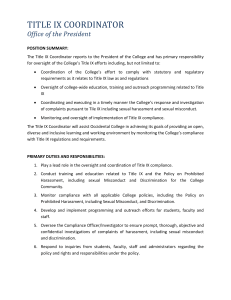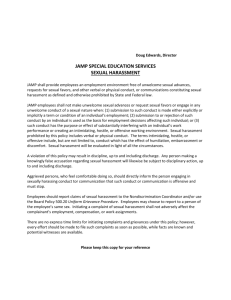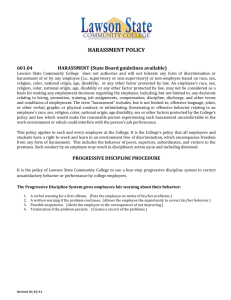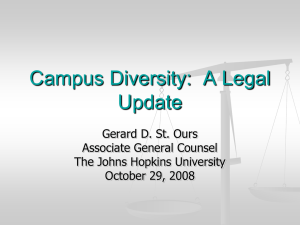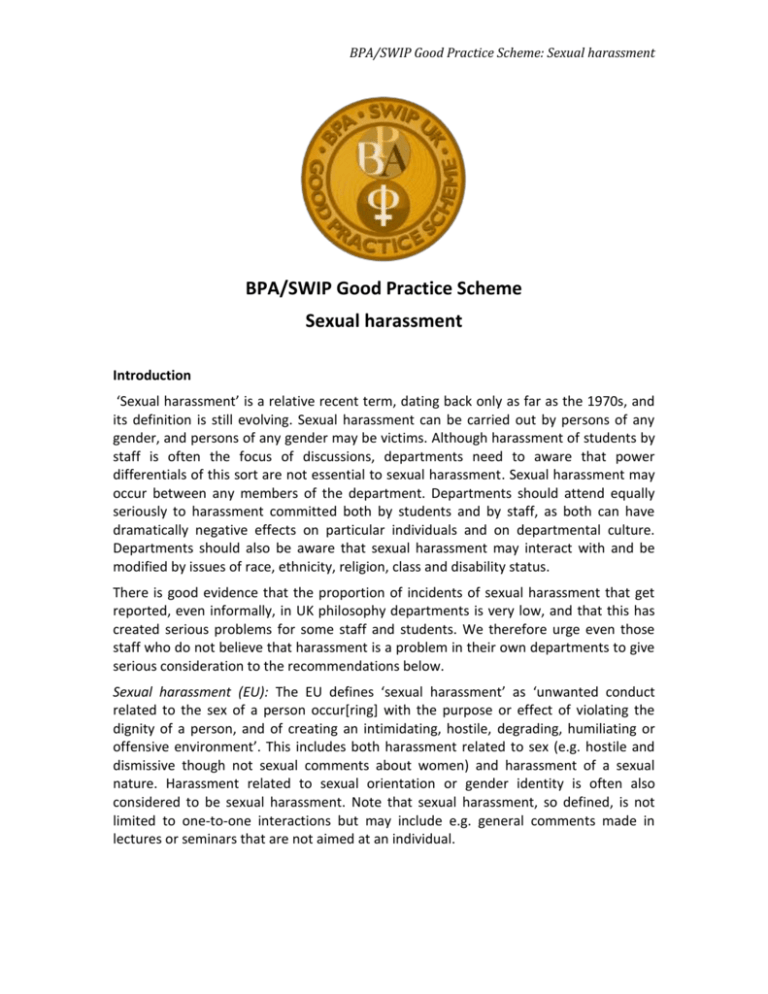
BPA/SWIP Good Practice Scheme: Sexual harassment
BPA/SWIP Good Practice Scheme
Sexual harassment
Introduction
‘Sexual harassment’ is a relative recent term, dating back only as far as the 1970s, and
its definition is still evolving. Sexual harassment can be carried out by persons of any
gender, and persons of any gender may be victims. Although harassment of students by
staff is often the focus of discussions, departments need to aware that power
differentials of this sort are not essential to sexual harassment. Sexual harassment may
occur between any members of the department. Departments should attend equally
seriously to harassment committed both by students and by staff, as both can have
dramatically negative effects on particular individuals and on departmental culture.
Departments should also be aware that sexual harassment may interact with and be
modified by issues of race, ethnicity, religion, class and disability status.
There is good evidence that the proportion of incidents of sexual harassment that get
reported, even informally, in UK philosophy departments is very low, and that this has
created serious problems for some staff and students. We therefore urge even those
staff who do not believe that harassment is a problem in their own departments to give
serious consideration to the recommendations below.
Sexual harassment (EU): The EU defines ‘sexual harassment’ as ‘unwanted conduct
related to the sex of a person occur[ring] with the purpose or effect of violating the
dignity of a person, and of creating an intimidating, hostile, degrading, humiliating or
offensive environment’. This includes both harassment related to sex (e.g. hostile and
dismissive though not sexual comments about women) and harassment of a sexual
nature. Harassment related to sexual orientation or gender identity is often also
considered to be sexual harassment. Note that sexual harassment, so defined, is not
limited to one-to-one interactions but may include e.g. general comments made in
lectures or seminars that are not aimed at an individual.
BPA/SWIP Good Practice Scheme: Sexual harassment
Sexual harassment (your institution): Institutional definitions of ‘sexual harassment’
differ greatly from one another. Some institutional definitions focus solely on sexual
conduct, while others include also include non-sexual harassment related to sex.
While departments need to attend to their institution’s definition of ‘sexual
harassment’, and to make use of institutional procedures where appropriate, this is not
the end of their responsibilities. Where sexist or sexual behaviour is taking place that
contributes to an unwelcoming environment for women (or other groups), departments
should act whether or not formal procedures are possible or appropriate.
For further information on the BPA/SWIP Good Practice Scheme, please see our general
guidance notes on the BPA Good Practice website (bpa.ac.uk/resources/women-inphilosophy/good-practice).
Recommendations
Availability of information and advice
All members of the department—undergraduates, postgraduates, academic and
non-academic staff— should be made aware of the regulations that govern sexual
harassment in their university. In particular, they should know the university’s
definition of ‘sexual harassment’ and who to contact in possible cases of sexual
harassment. They should also know who has standing to file a complaint (in general,
and contrary to widespread belief, the complainant need not be the victim). They
should be made aware of both formal and informal measures available at their
university. Departments may wish to consider including this information in induction
sessions for both students and staff, and in training for teaching assistants.
Where the University or Faculty has a list of Harassment Contacts (see e.g.
www.southampton.ac.uk/diversity/how_we_support_diversity/harassment_contact
s.page), all staff – including non-academic staff – and students should be made
aware of it. If no such list exists, the department should consider suggesting this
approach to the university. It is very important for department members to be able
to seek advice outside their department.
All members of staff should read the advice given at www.oed.wisc.edu/
sexualharassment/guide.html on how to deal with individuals who approach them
to discuss a particular incident.
All of the information listed above should be made permanently available to staff
(including non-academic staff) and students, e.g. through a stable URL and/or staff
and student handbooks, rather than only in the form of a one-off email
communication.
The HoD and others with managerial responsibilities (such as Directors of
Postgraduate and Undergraduate Studies) should make sure that they have full
knowledge of university procedures regarding sexual harassment.
BPA/SWIP Good Practice Scheme: Sexual harassment
Departmental culture
The department should take seriously the harms of an atmosphere rife with
dismissive or sexualizing comments and behaviour. (It is worth noting, however, that
the right way to deal with this may vary. For more on this, see Saul, ‘Stop thinking
(so much) about “sexual harassment”, available on the Good Practice website.)
The department should — from the top down — cultivate an atmosphere in which
maintaining a healthy climate for all department members, especially those from
under-represented groups and including non-academic staff, is considered
everyone’s responsibility. What this entails will vary from person to person and
situation to situation. But at a minimum it includes a responsibility to reflect on the
consequences (including unintended consequences) of one’s own behaviour
towards women. It may also include a responsibility to intervene, either formally or
informally. (For more on the range of responses available, see Saul, op. cit.)
The department should ensure that those raising concerns about sexual harassment
are, as far as possible, protected against retaliation.
Departments may want to give bystander training either to staff, or to staff and
postgraduates, if this is available or can be made available by the institution. This
can help bystanders to feel comfortable intervening when they witness harassing
behaviour. (See the Good Practice website for more information.)




